| |

| Author |
Topic Options
|

 Posts:
Posts: 9914
 Posted: Posted: Sat Feb 21, 2009 1:43 pm
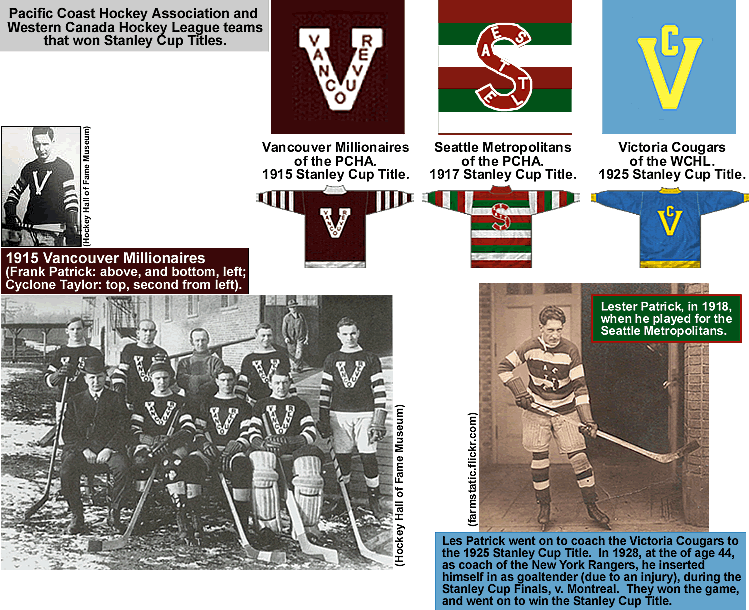 Find cool stuff from hockey's history!
|

 Posts:
Posts: 9914
 Posted: Posted: Sun Mar 01, 2009 9:44 pm
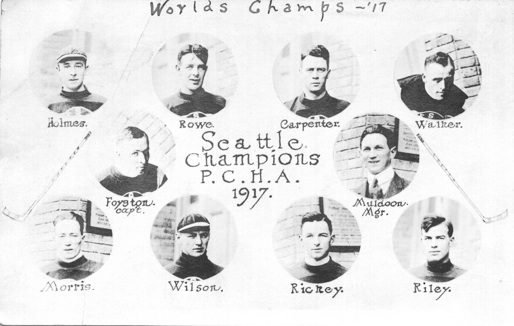 The Seattle Metropolitians were the first American team to win the Stanley Cup in 1917.
|

 Posts:
Posts: 9914
 Posted: Posted: Sun Mar 01, 2009 9:51 pm
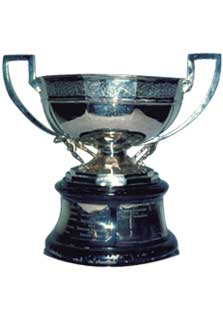 The Lester Patrick Cup was emblematic of the professional Western Hockey League. Originally, the Phil Henderson Cup was awarded from 1944-45 to 1950-51 to the playoff champions of the league. The Presidents Cup was then awarded to the playoff champions from 1951-52 to1959-60, and was renamed in 1960-61 to honour the late Lester Patrick following his death. The league originated as an amateur loop called the Pacific Coast Hockey League in 1944-45. The league turned professional in 1948-49 and changed its name to the Western Hockey League in 1952-53. It operated with teams in the Western United States and Western Canada until 1973-74 when it suspended operations. -------------------------------------------------------------------------------- ALL-TIME WINNERS -------------------------------------------------------------------------------- 1973-74 Phoenix Roadrunners 1972-73 Phoenix Roadrunners 1971-72 Denver Spurs 1970-71 Portland Buckaroos 1969-70 Vancouver Canucks 1968-69 Vancouver Canucks 1967-68 Seattle Totems 1966-67 Seattle Totems 1965-66 Victoria Maple Leafs 1964-65 Portland Buckaroos 1963-64 San Francisco Seals 1962-63 San Francisco Seals 1961-62 Edmonton Flyers 1960-61 Portland Buckaroos 1959-60 Vancouver Canucks 1958-59 Seattle Totems 1957-58 Vancouver Canucks 1956-57 Brandon Regals 1955-56 Winnipeg Warriors 1954-55 Edmonton Flyers 1953-54 Calgary Stampeders 1952-53 Edmonton Flyers 1951-52 Saskatoon Quakers 1950-51 Victoria Cougars 1949-50 New Westminster Royals 1948-49 San Diego Skyhawks 1947-48 Vancouver Canucks 1946-47 Los Angeles Monarchs 1945-46 Vancouver Canucks 1944-45 Seattle Iromen
|

 Posts:
Posts: 9914
 Posted: Posted: Sun Mar 01, 2009 10:06 pm
 Willie O'Ree became hockey's version of Jackie Robinson on Jan. 18, 1958, when he made his NHL debut with the Boston Bruins. Despite being legally blind in his right eye (due to an errant puck that felled him two years earlier - a trait he kept secret), O'Ree rocketed through juniors and the minors, and reached the pinnacle of the hockey world. He played just two games with the Bruins that year, was sent down to the minors for the following two, and didn't come back to the NHL until 1961, when he returned for a 43-game stint. Through it all, he was met with an endless stream of verbal abuse.
|
 Posted: Posted: Mon Mar 02, 2009 12:42 am
Can I put my historic pic up?...i was the first girl to play boys hockey in Van  Of course I dont want my damn pic put up....such a geeky looking kid 
|

Regina 
Site Admin

 Posts:
Posts: 32460
 Posted: Posted: Mon Mar 02, 2009 6:23 am
|

 Posts:
Posts: 9914
 Posted: Posted: Tue Mar 03, 2009 9:50 pm
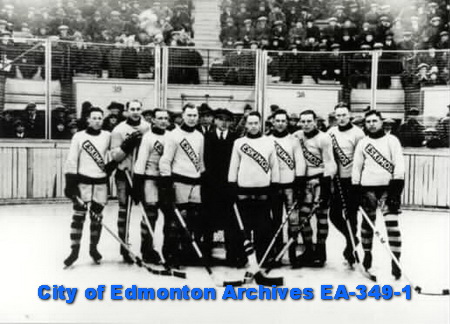 The Edmonton Eskimos (first known as the Edmonton Hockey Club) were a Canadian amateur and later professional men's ice hockey team that existed from 1905 to 1927. The Eskimos challenged three times for the Stanley Cup, losing each time; in 1908 versus the Montreal Wanderers, in 1910 versus the Ottawa Senators, and Ottawa again in 1923. The Eskimos beat the Regina Capitals to win the 1923 WHL playoffs. They were also the 1923 regular league champions. The Eskimos came in second in the 1922 and 1926 WCHL playoffs. Team alumni include Eddie Shore. An Edmonton Eskimos team also played in the Alberta Senior Hockey League in the late 1930s. Other teams in the ASHL included the Calgary Stampeders and the Drumheller Miners; the latter team featured four Bentley brothers, three of whom played in the NHL and two of whom are enshrined in the Hockey Hall of Fame. Founded as the Edmonton Hockey Club in 1905, the club helped found the Alberta Amateur Hockey Association in 1907. In 1908 and 1910, the Edmonton club would challenge for the Stanley Cup. Although the club was technically amateur, the club hired Tommy Phillips, Didier Pitre and Lester Patrick for the challenge, and only one player who had played from the regular season played in the challenge against the Montreal Wanderers. It was to no avail, as the Wanderers won the series. The Edmonton Hockey Club folded after 1910, and the Eskimos club was formed for the 1910-11 season by Deacon White from the remains of the organization. In 1919-20, the AAHA formed the "Big Four" senior league, composed of two teams in Edmonton, and two in Calgary. This league folded in 1921, and the Eskimos helped to found the Western Canada Hockey League. In 1922-23, Edmonton would win the WCHL championship and played in the Stanley Cup finals against Ottawa
|

 Posts:
Posts: 9914
 Posted: Posted: Tue Mar 03, 2009 9:51 pm
|
 Posted: Posted: Tue Mar 03, 2009 9:51 pm
I really like this thread ![Drink up [B-o]](./images/smilies/drinkup.gif)
|

 Posts:
Posts: 9914
 Posted: Posted: Tue Mar 03, 2009 10:29 pm
Thank you...  The Manitoba Hockey Association was an early men's senior ice hockey league playing around 1900 in Manitoba, Canada. The league started as an elite amateur league, became professional in 1905, had a professional and an amateur league in 1908–09 and only amateur from 1909 until 1923. Two teams from this league have won the Stanley Cup, the Winnipeg Victorias and the Kenora Thistles. Three other teams from the league have challenged for the Stanley Cup: Brandon Wheat Cities, Winnipeg Maple Leafs, and the Winnipeg Rowing Club. Other teams have won the Allan Cup: Winnipeg Hockey Club, Winnipeg Falcons, Winnipeg Monarchs and Winnipeg Victorias. It also was known as the Manitoba Hockey League and Manitoba Professional Hockey League in following years. The Winnipeg Victorias where the first team from outside Quebec to win the Stanley cup in 1896.  Up along the coast of the Lake Of The Woods in northwestern Ontario lies the port town of Kenora, home of the 1907 Stanley Cup Champion Kenora Thistles. 
|

 Posts:
Posts: 9914
 Posted: Posted: Tue Mar 03, 2009 10:58 pm
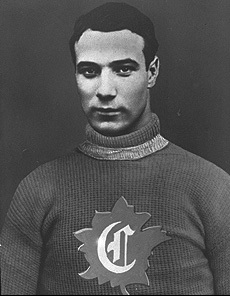 Edouard "Newsy" Lalonde (October 31, 1887, Cornwall, Ontario – November 21, 1970) was a Canadian professional ice hockey forward in the National Hockey League (NHL) and a professional lacrosse player, regarded as one of hockey's and lacrosse's greatest players of the first half of the 20th century and one of sport's most colourful characters. He played for the Montreal Canadiens -- considered to be the original "Flying Frenchman" -- in the National Hockey Association and the NHL. He also played for the WCHL's Saskatoon Sheiks. Before playing professional ice hockey, he worked in a newspaper plant, where he acquired the "Newsy" moniker. The image on the right is of Lalonde, in the 1910–11 season and the second version of the Montreal uniform; the "CH" sweater was still almost a decade away. A leading scorer for the Canadiens in six years, he served as captain from 1915 to 1921. He was a member of the first Montreal Canadiens team to win the Stanley Cup in 1916. He was scoring champion seven times in the National Hockey Association, Pacific Coast Hockey Association, National Hockey League and Western Hockey League, an unprecedented feat in the major professional ranks and unsurpassed until Wayne Gretzky's tenth scoring title in 1994. From 1910 to 1954, he held the record for the most goals scored by a major league hockey player, including his pre-NHL totals -- 455 goals, a record later broken by Maurice Richard. On a more personal level, he was said to have been one of the meanest players of his time; hated by opposition players and even by some of his teammates. As a coach, he once punched one of his players who tried to stand up to him, as a warning to the team, that he wouldn't take any talk-back. In 1950, he was named athlete of the half century in lacrosse. He was also elected to the Hockey Hall of Fame in 1950, the Canadian Lacrosse Hall of Fame in 1965, and the Sports Hall of Fame of Canada. He had lit the torch when the Sports Hall of Fame opened in Toronto in August, 1955. In 1998 he was ranked number 32 on The Hockey News' list of the 100 Greatest Hockey Players, making him the highest-ranking player on the list who had played in a professional league before the founding of the NHL.
|

 Posts:
Posts: 9914
 Posted: Posted: Wed Mar 04, 2009 8:52 am
 The Dawson City Nuggets were a hockey team from Dawson City, Yukon Territory, Canada that challenged the reigning champion Ottawa Senators, aka Silver Seven in January, 1905, for the Stanley Cup, and suffered the most lopsided single-game defeat in the history of Stanley Cup play. Sponsored by the Klondike entrepreneur Joseph W. Boyle from men of the mining camps during the tailend of the Yukon gold rush, the Nuggets travelled an epic month-long voyage by dog sled (Dawson to Whitehorse), ship (Skagway to Vancouver) and train (Whitehorse to Skagway, and Vancouver to Ottawa) to reach Ottawa in time for the games. The team had only one bona-fide player, ex-Ottawa star Weldy Young, but he was unable to make it to Ottawa in time, delayed in Dawson City as an election official. Exhausted by the trip and without Young, they lost the first game of the two-game total goal series 9-2, and the second 23-2, in which Ottawa star Frank McGee set a record that still stands of scoring fourteen goals. The team then played a series of exhibition games in the East before returning to the Yukon. The Nuggets participated in perhaps the most famous Stanley Cup challenge of all, against the Ottawa Hockey Club, a.k.a "The Silver Seven" in 1905. Dawson City had two former elite hockey players, Weldy Young who had played for Ottawa in the 1890s and D. R. McLennan who had played for Queen's College against the Montreal Victorias in the challenge of 1895. Other players were selected from other Dawson City clubs. Dawson City's challenge was accepted in the summer of 1904 by the Stanley Cup trustees, scheduled (inauspiciously) for Friday January 13, 1905. The date of the challenge meant that Young had to travel later as he had to work in a federal election that December, and meet the club in Ottawa. To get to Ottawa, several thousand miles away, the club would have to get to Whitehorse by road, catch a train from there to Skagway, Alaska, then catch a steamer to Vancouver, and a train from there to Ottawa. On December 18, 1904 several players set out by dogsled and the rest left the next day by bicycle for a 330 mile trek to Whitehorse. At first the team made good progress, but the weather turned warm enough to thaw the roads, meaning the players had to walk several hundred miles. The team would spend the nights in police sheds along the road. At Whitehorse, the weather turned bad, causing the trains not to run for three days, causing the Nuggets to miss their steamer in Skagway. The next one could not dock for three days due to the ice buildup. The club would find the sea journey treacherous, causing seasickness amongst the team. When the steamer reached Vancouver, the area was too fogged in to dock, and the steamer docked in Seattle. The team from there caught a train to Vancouver, and finally left Vancouver on January 6, 1905, arriving in Ottawa on January 11. Despite the difficult journey, the Ottawa squad refused to change the date of the first game, only two days away. Otherwise, Ottawa was hospitable. The Klondikers received a huge welcome at the train station, had a welcoming dinner, and used the Ottawa Amateur Athletic Club's rooms for the duration of their stay. Young would not arrive in time to play for Dawson. The first game started well for Dawson, being only down 3–1 at the half, but things turned ugly afterwards. Norman Watt of Dawson tripped Ottawa's Art Moore, who retaliated with a stick to the mouth of Watt, who promptly knocked Moore out hitting him on the head with his stick. The game ended 9–2 for Ottawa. The game left a poor taste in the Klondikers, complaining that several goals were offside. Watt made the mistake of saying that Frank McGee wasn't that good as he had only scored one in the first game. McGee would score 4 goals in the first half of the second match and 10 in the second half leading Ottawa to a 23–2 score. Despite this high score, the newspapers claimed that Albert Forrest, the Dawson City goalie had played a "really fine game", otherwise the score "might have been doubled". Ottawa would celebrate by hosting Dawson at a banquet, then players would take the Cup and would attempt to drop-kick it over the Rideau Canal. The stunt was unsuccessful, the Cup landing on the frozen ice, to be retrieved the next day.
|

 Posts:
Posts: 9914
 Posted: Posted: Wed Mar 04, 2009 9:39 am
 Toronto St. Pats 1921-22 The Western Canada Hockey League began with the 1921-22 season, and the playoff structure was altered as a result. The winners of the two Western leagues would meet to decide a winner, with the victor heading east to face the NHL champion in a best of five series. The Vancouver Millionaires defeated the Regina Capitals to earn the right to face the Toronto St. Pats. The series took all five games, but the city of Toronto would win its second Stanley Cup. Toronto goaltender John Ross Roach recorded the first Stanley Cup shutout by a rookie, and posted an excellent 1.80 goals-against average. Babe Dye of the St. Pats notched nine of the club's 16 goals. There have been many spectacular beginnings held at Windsor Arena over the rink's lengthy history. But the night of Feb. 15, 1927 was all about the end of an era. Toronto's National Hockey League history was not much to talk about during the infancy of the league. True, there were Stanley Cup wins by the Arenas (1917-18) and the St. Patricks (1921-22), but considering the club was also briefly called the Tecumsehs, Toronto actually had more nicknames than titles to its credit. That was all about to change as the St. Patricks travelled to Windsor for a game with the Detroit Cougars. An expansion franchise, the Cougars -- who would eventually become the Red Wings -- were without a rink in Detroit during their inaugural NHL campaign and played all of their 1926-27 home dates at Windsor Arena. SNOWY NIGHT Neither team was left with much to shout about as they met on a bitter winter's evening. Both were en route to missing the playoffs and the snow storm that night kept the crowd at the game down to a paltry 150. The St. Patricks were up for sale and Philadelphia interests made inquiries about purchasing the club and relocating it to the City of Brotherly Love. A group of 14 Toronto businessman led by Conn Smythe stepped in Feb. 14, 1927 and bought the St. Patricks for $160,000. Immediately, they were offered $200,000 by the Philadelphia group, an offer they refused. Smythe was installed as coach and general manager of the club, a move that was to take effect at the start of the 1927-28 season. They picked a new name, logo and colour scheme for the club -- something they planned to unveil at the club's next home game. Feb. 17 against the New York Americans at Mutual Street Arena. First, there was the matter of the Feb. 15 road game in Windsor against Detroit. Toronto played the game wearing their green-and-white sweaters with the shamrock logo for the final time.
|

 Posts:
Posts: 9914
 Posted: Posted: Wed Mar 04, 2009 9:05 pm
The list of now defunct NHL teams that either disappeared or moved to another city.
Atlanta Flames (1972-1980; became Calgary Flames)
Brooklyn Americans (1941-1942)
California Golden Seals (1970-1974; became California Seals)
California Seals (1974-1976; became Cleveland Barons)
Cleveland Barons (1976-1978)
Colorado Rockies (1976-1982; became New Jersey Devils)
Detroit Cougars (1926-1930; became Detroit Falcons)
Detroit Falcons (1930-1932; became Detroit Red Wings)
Hamilton Tigers (1920-1925; became New York Americans)
Hartford Whalers (1979-1997; became Carolina Hurricanes
Kansas City Scouts (1974-1976; became Colorado Rockies)
Minnesota North Stars (1967-1993; became Dallas Stars)
Montreal Maroons (1924-1938)
Montreal Wanderers (1917-1918)
New York Americans (1925-1941; became Brooklyn Americans)
Oakland Seals (1967-1970; became California Golden Seals)
Ottawa Senators (1917-1934; a new team of the same name was formed in 1992)
Philadelphia Quakers (1930-1931)
Pittsburgh Pirates (1925-1930; became Philadelphia Quakers)
Quebec Bulldogs (1919-1920; became Hamilton Tigers)
Quebec Nordiques (1979-1995; became Colorado Avalanche)
Saint Louis Eagles (1934-1935)
Toronto Arenas (1917-1919; became Toronto St. Patricks)
Toronto St. Patricks (1919-1926; became Toronto Maple Leafs)
Winnipeg Jets (1979-1996; became Phoenix Coyotes)
|

 Posts:
Posts: 9914
 Posted: Posted: Wed Mar 04, 2009 9:28 pm
 Rover, Shoots Left, 5' 8", 165 lbs. Born: Tara, Ontario - June 23, 1885 Fred Taylor was absolutely the grandest star of his era. Fred “Cyclone” Taylor was one of professional hockey’s first superstars. While Fred was playing for the Ottawa Senators in 1907, Canada’s Governor General was so impressed with his incredible Speed that he coined the name of Cyclone, and it stayed with him the rest of his life. Cyclone Taylor played in 4 Stanley Cup series during his 18 years of professional hockey. He won the cup in 1909 with Ottawa and in 1915 with the Vancouver Millionaires. The other two series Cyclone played in with the Vancouver Millionaires they lost to Toronto in 1918 and to Ottawa in 1921. His daring rushes up the ice with the puck gave Ottawa and Vancouver fans much to cheer about as Cyclone brought Stanley Cup championships to both cities. When Taylor was signed by the Renfrew Creamery Kings in 1909 he reportedly signed a contract to pay him $5250 for the 12-game season, the richest contract in North American sports history at the time on a per-game basis. Taylor grew up in Listowel, Ontario and was banned from the Ontario Hockey Association when he refused to leave his Listowel club for the Toronto Marlboros. Subsequently, Taylor left Ontario for Portage-La-Prairie, Manitoba in 1905 to play hockey. Less than a year later, Taylor signed a contract with the IHL and became a star as a member of the Houghton Portage Lakers based in Michigan. In 1907-1908, Taylor jumped to the Ottawa Senators of the ECAHA due to the failure of the IHL.Taylor, a forward, was moved to defense to play a position called "cover-point" because as a forward he was always too far in front of his linemates. As a defenseman he could roam the ice at will and get back to his own end of the ice in time to make defensive plays.When the Renfrew squad disbanded, Taylor sat out a year and then surprisingly signed with the Vancouver Millionaires of the PCHA. Taylor switched back to forward and rover and led the PCHA in scoring five times, three of those years also leading the league in goals. Taylor stands as the PCHA's career assists leader and ranks fifth on the PCHA all-time goals list. Taylor only trails teammate Mickey MacKay on the PCHA all-time points list. Taylor, truly one of the game's greats, was inducted into Hockey's Hall of Fame in 1947.His nicknames, 'The Listowel Pistol" and his more famous "Cyclone," are tributes to his unmatched speed on the ice. Elected to Hockey's Hall of Fame in 1947 Won 2 Stanley Cup Championships (1909, 1915) Cyclone passed away in 1979 at the age of 94
|
 
|
Page 1 of 4
|
[ 46 posts ] |
Who is online |
Users browsing this forum: No registered users and 1 guest |
|
|

